Tran Temple in Nam Dinh, a sacred symbol and pride of the Vietnamese people, is not only a historical relic but also a unique spiritual and cultural destination, attracting visitors from all over. Every spring, the Seal Opening Ceremony at Tran Temple joyfully welcomes thousands of pilgrims, and in August of the lunar calendar, the Tran Temple Festival jubilantly takes place, recreating the traditional beauty of the nation. Join “Du lịch khắp thế gian” (Travel Around The World) to explore the cultural beauty, history, and profound spiritual experiences when visiting Tran Temple, the sacred temple in the land of Thanh Nam.
History of Tran Temple: Imprints of the Prosperous Tran Dynasty
Tran Temple is located on Tran Thua Street, Loc Vuong Ward, Nam Dinh City, Nam Dinh Province, on a bustling section of National Highway 10. This place is not just a temple, but also a national historical and cultural relic complex, the spiritual resting place of 14 Tran dynasty kings, their families, and illustrious generals. The Tran Dynasty, with its glorious victories against the Mongol invaders, etched bright golden pages into the nation’s history.
The Tran Temple festivals, especially the Seal Opening Ceremony at the beginning of the year and the August festival, are occasions for people to commemorate the merits of their ancestors, and immerse themselves in a rich traditional cultural space. Tran Temple is not only a tourist destination but also a symbol of patriotism, national pride, and the connection between a heroic past and a bright present.
Regarding its formation history, Tran Temple was built in 1695, on the very foundations of the former Tran Dynasty Thái miếu (Royal Ancestral Temple), which was Thiên Trường Palace. Thiên Trường Palace was once the “second capital” of Đại Việt during the Tran Dynasty, second only to Thăng Long in position and importance. In 1258, when the Mongol army invaded, Thiên Trường Palace became a solid base, where the Tran Dynasty implemented the “empty garden, empty house” strategy, withdrawing from Thăng Long and consolidating forces.
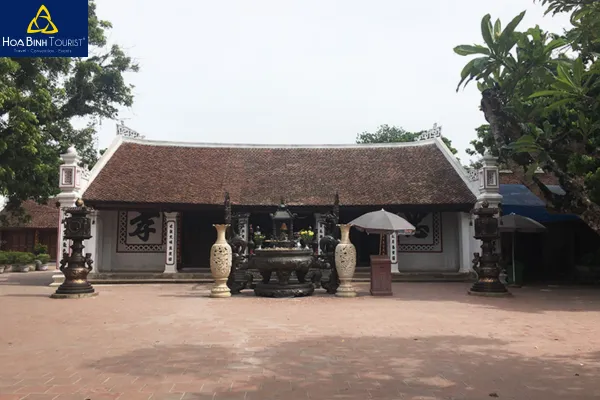
At Thiên Trường Palace, on the 14th day of the first lunar month in 1258, King Tran Thai Tong held a grand banquet, rewarding and bestowing titles upon meritorious generals. The seal opening ceremony was also conducted during this occasion, carrying the meaning of praying for national peace and prosperity, and a new year of favorable weather and good harvests. Since then, the Seal Opening Ceremony at Tran Temple has become a traditional ritual, held annually at the beginning of spring, expressing gratitude to ancestors and aspirations for a new year of peace and luck.
Exploring the Unique Architecture and Main Areas of Tran Temple
The Tran Temple relic complex includes three main temples: Thiên Trường Temple (Upper Temple), Cố Trạch Temple (Lower Temple), and Trùng Hoa Temple. Each temple possesses a unique architectural beauty, harmonizing within a sacred and ancient space.
Thiên Trường Temple, also known as the Upper Temple, is the center of the relic site. The temple was built on the foundation of the Tran clan’s ancestral shrine, then the Thái Miếu (Royal Ancestral Temple) and Trùng Quang Palace. This place was once where the Tran Dynasty’s retired emperors lived and worked. The architecture of Thiên Trường Temple consists of 9 buildings and 31 rooms, with a solid ironwood frame, mossy tile roofs, and ancient Bat Trang brick floors. Entering the temple, visitors will explore the front hall, middle hall, main sanctuary, incense burning house, along with the left and right corridors, and East-West side houses.
The 5-room front hall, 13m long, stands out with 12 main pillars and 12 auxiliary pillars placed on sophisticated lotus petal-carved stone pedestals, which were originally the pillar bases of the ancient Trùng Quang Palace. Inside the front hall is where the mandarins who assisted the Tran Dynasty are worshiped. The middle hall worships 14 ancestral tablets of the Tran kings, with three ceremonial thrones placed in front for respectful salutations. The 3-room main sanctuary, with the central room worshiping the progenitor of the Tran clan and the principal wives, and the two side rooms worshiping royal consorts. The kinh đàn (incense burning house) worships meritorious officials, civil mandarins, and military mandarins of the Tran Dynasty.
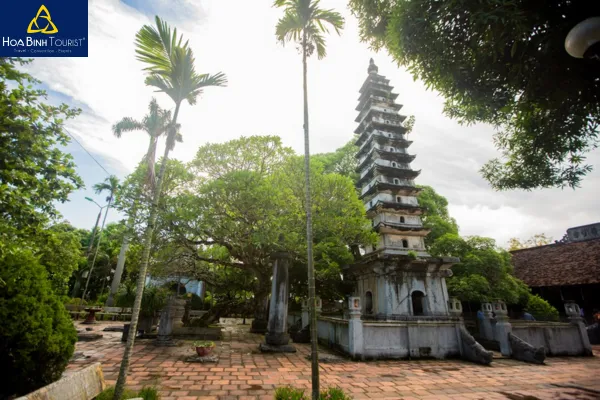
Cố Trạch Temple, or Lower Temple, is located east of the relic complex. In 1868, a broken stele was discovered with the inscription “Hưng Đạo thân vương cố trạch” (Residence of Prince Hung Dao) in the east of this area. In 1895, Cố Trạch Temple was built, worshiping Hung Dao Vuong Tran Quoc Tuan, his family, and his generals. The front hall of Cố Trạch Temple worships the ancestral tablets of three trusted generals of Tran Hung Dao: Pham Ngo, Nguyen Che Nghia, and Pham Ngu Lao. The middle hall worships statues and ancestral tablets of Tran Hung Dao and his four sons, Pham Ngu Lao, and the left and right generals. The main sanctuary worships Tran Hung Dao’s parents, Tran Hung Dao himself, his wife (Princess Thien Thanh), children, daughters-in-law, and sons-in-law.
Trùng Hoa Temple is located to the left of Thiên Trường Temple, built in 2000 on the foundation of the former Trùng Hoa Palace, where the Tran kings often came to consult with retired emperors. Trùng Hoa Temple is solemn with 14 bronze statues of the 14 Tran kings placed in the middle hall and main sanctuary. The incense burning house worships thrones and ancestral tablets of generals. The left corridor worships civil mandarins, and the right corridor worships military mandarins.
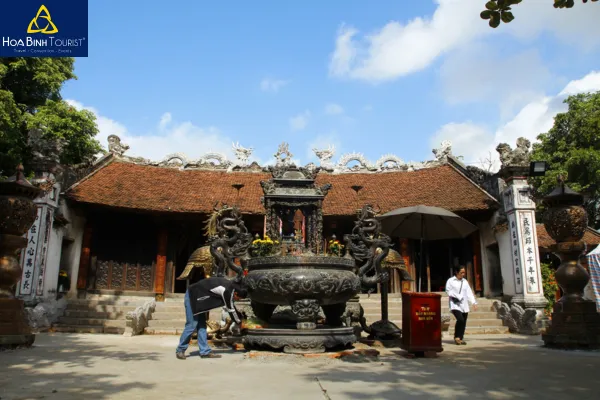
Tran Temple Festival: A Convergence of Culture and Spirituality
The Tran Temple Festival is one of the largest and most important festivals in Nam Dinh province, taking place twice a year: the Seal Opening Ceremony in January and the main festival in August of the lunar calendar. Both festivals attract a large number of tourists and local people, creating a bustling and solemn atmosphere.
The Seal Opening Ceremony at Tran Temple takes place from the 14th to the 15th day of the first lunar month. The main ritual begins at the Tý hour (1:00 AM) on the 15th, with activities such as procession of the seal casket from Co Trach Temple to Thien Truong Temple and the seal opening ceremony. Prior to that, from the 14th, rituals such as the Ngọc Lộ palanquin procession (carrying the incense burner of Buddha Emperor Tran Nhan Tong from Pho Minh Pagoda), the Water and Fish procession (commemorating the riverine origin of the Tran Dynasty), and the Upper Yuan Full Moon Tet ceremony of the first lunar month are also held.
Exactly at the Tý hour on the 15th, the official seal opening ceremony begins. After the seal is opened, people flock into the temple to worship and pray for a seal. Praying for a seal at Tran Temple signifies wishing for luck, fortune, fame, and peace in the new year. Many people and tourists arrive early, queuing in long lines for a chance to receive the sacred seal.
The Tran Temple seal is engraved with four characters “Tích phúc vô cương,” meaning educating descendants about accumulating virtue and doing good deeds, so that virtue and blessings last long and fortune abounds. The Seal Opening Ceremony at Tran Temple is not only a spiritual ritual but also a precious cultural heritage, preserved and developed through many generations.
How to hang the Tran Temple seal is also a concern for many people. According to feng shui experts, the seal should be hung in solemn positions such as on the wall, behind the desk. Hanging the seal facing West to increase wealth, facing North for promotion, and facing Southeast to strengthen health. It is important to note that the seal should not be placed on the ancestral altar to maintain solemnity and sacredness.

The Tran Temple Festival in August takes place from the 15th to the 20th day of the 8th lunar month. The festival begins with palanquin processions from surrounding communal houses and temples to Thien Truong Temple. Festivals in even-numbered years are usually organized on a larger scale than odd-numbered years, but regardless of the year, the festival atmosphere is very jubilant, attracting a large number of tourists.
The ceremonial part of the August festival is very solemn, with palanquin processions, incense offerings, and sacrifices at the Upper Temple. In particular, the incense offering ceremony is performed by 14 virgin girls, carrying 14 trays of flowers, walking in solemn ceremonial music, recreating the ancient royal court scene. The festival part of the August festival is very rich and attractive with many traditional cultural activities such as chicken fighting, martial arts performances, wrestling, lion dances, Chinese chess games, kiều bridge walking, hát văn (spiritual singing), bài bông dance… These activities create a special attraction of the Tran Temple festival, attracting tourists from all over to participate.
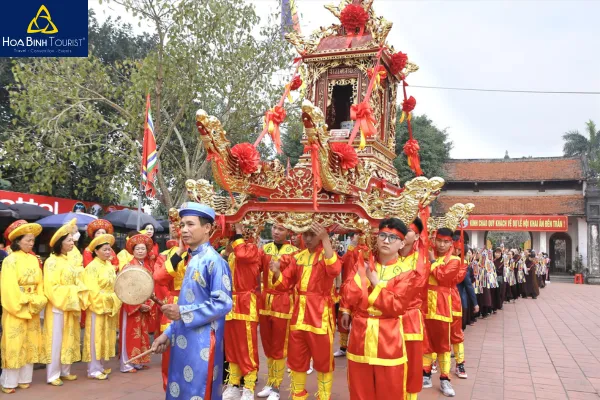
Visiting Tran Temple: Detailed Guide 2024
To have a complete and meaningful visit to Tran Temple, tourists need to grasp the following useful travel tips:
Ideal time to visit: Tran Temple is open year-round, but the best time to visit the temple is during the festival season, especially the Seal Opening Ceremony in January and the August festival. However, if you want to avoid crowds, you can come at other times of the year.
Transportation: Tran Temple is about 85km from Hanoi, with many means of transportation:
- Car/Motorbike: Follow the Phap Van – Cau Gie highway, then follow National Highway 1A or National Highway 10 to Nam Dinh. The road is quite easy and convenient.
- Coach: There are many high-quality coach companies going to Nam Dinh from bus stations in Hanoi (Giap Bat, Nuoc Ngam…). Arriving at Nam Dinh bus station, you can take a taxi or motorbike taxi to Tran Temple (about 4km).
- Airplane: If you are far away, you can fly to Noi Bai Airport (Hanoi) and then take a coach or taxi to Nam Dinh.
Cost:
- Entrance fee: Free.
- Parking fee: 10,000 – 20,000 VND.
- Food and drink: Costs depend on your choice, Nam Dinh cuisine is very diverse and rich with many delicious dishes at affordable prices.
- Accommodation: If you stay overnight in Nam Dinh, there are many hotels and guesthouses with different price ranges.
- Other expenses: Transportation costs, souvenir shopping, offerings…
Attractions: In addition to the three main temples, you can visit ancient architectural structures in the relic complex, learn about the history and culture of the Tran Dynasty.
Dining: Do not miss the opportunity to enjoy Nam Dinh cuisine with famous specialties such as:
- Nam Dinh Beef Noodle Soup (Phở bò Nam Định): Distinctive flavor, rich broth, tender and sweet beef.
- Grilled Fish Upside Down in a Pot (Cá nướng úp chậu): Unique dish, irresistible delicious flavor.
- Kenh Village Steamed Rice Rolls (Bánh cuốn làng Kênh): Paper-thin, fragrant wood ear mushroom and meat filling, served with sweet and sour dipping sauce.
- Savory Sticky Rice (Xôi xíu): Popular breakfast dish, sticky rice, rich char siu.
- Giao Thuy Fermented Pork Roll (Nem nắm Giao Thủy): Famous specialty, suitable as a gift.
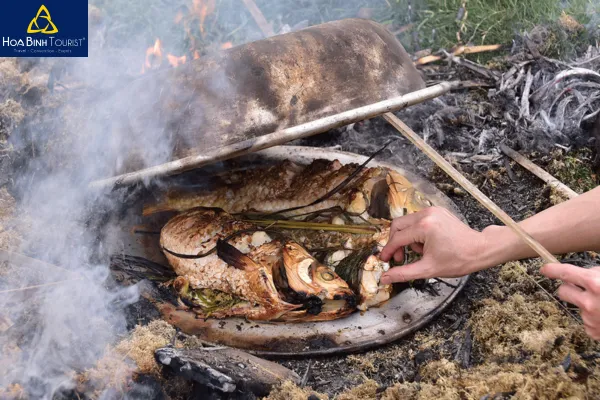
Notes when visiting Tran Temple:
- Attire: Choose modest, polite clothing suitable for the sacred space.
- Security: Be careful to protect personal belongings, especially during crowded festivals.
- Offerings: Prepare appropriate offerings if you intend to make offerings for peace, depending on your beliefs and personal conditions. There are many types of offerings such as vegetarian offerings, meat offerings, raw food offerings, sơn trang meat offerings, offerings to the young ladies and gentlemen deities, offerings to the Tutelary God, and Thu Dien offerings.
- Attitude: Maintain a respectful and solemn attitude when entering the temple.
Conclusion
Visiting Tran Temple is not just a tourist trip but also a journey back to the roots, exploring national history and culture. Coming to Tran Temple, visitors not only admire the ancient architecture and participate in traditional festivals but also feel the sacred and peaceful space, dispelling the worries of life. Come and experience the profound cultural, historical, and spiritual values at Tran Temple, a must-visit destination on the tourist map of Vietnam.